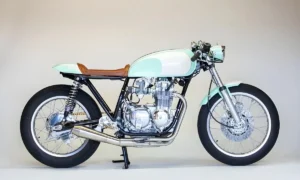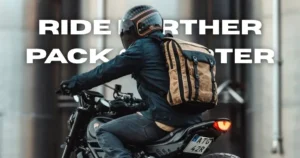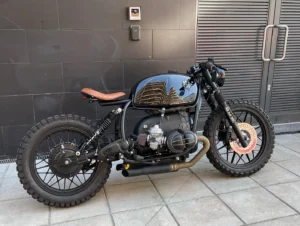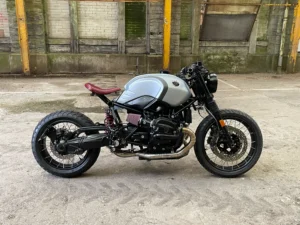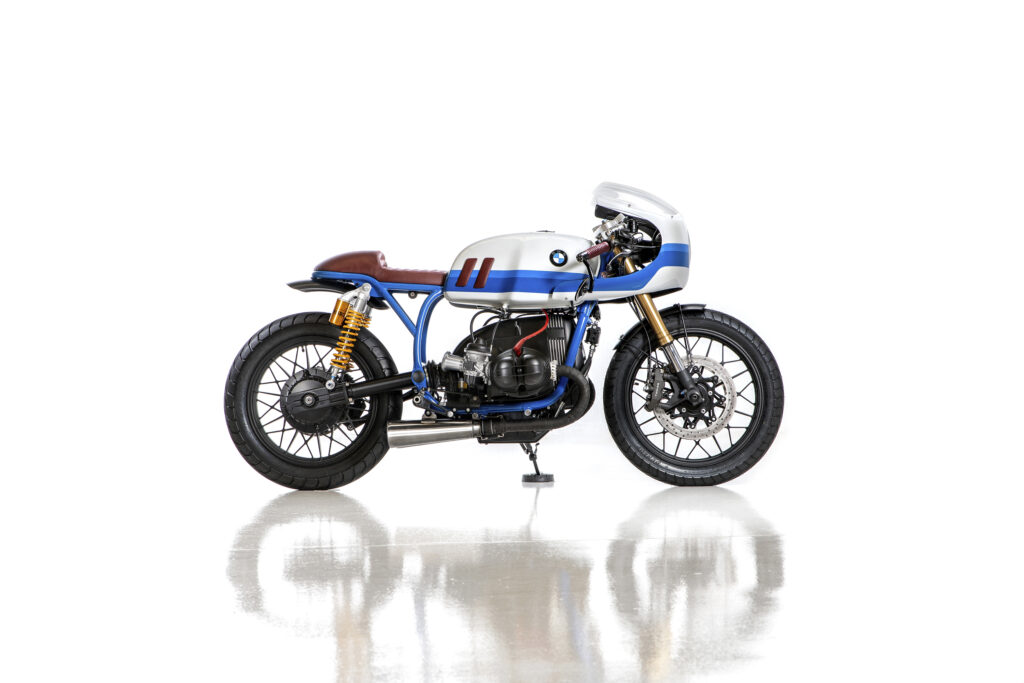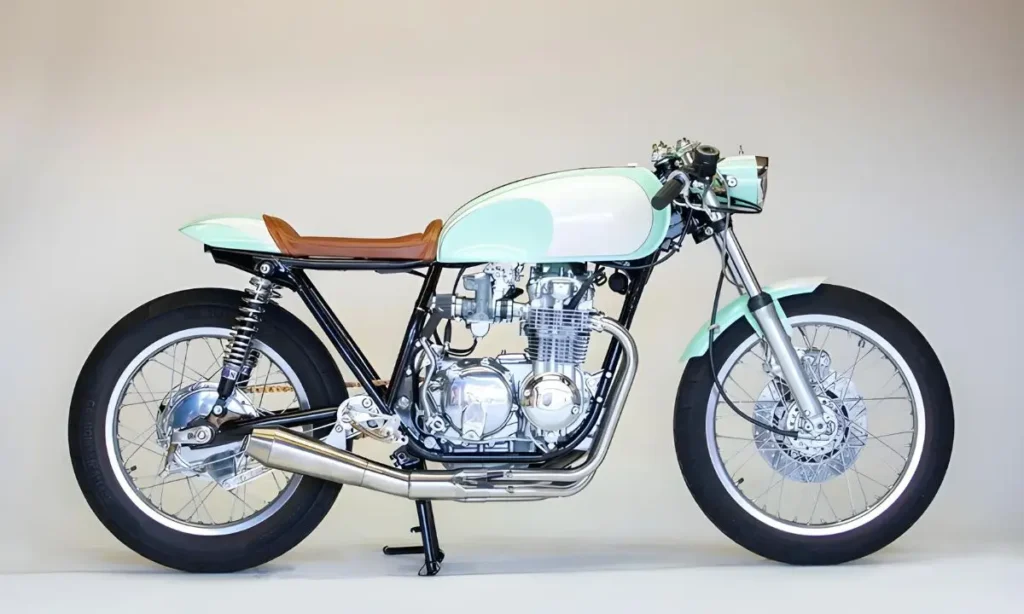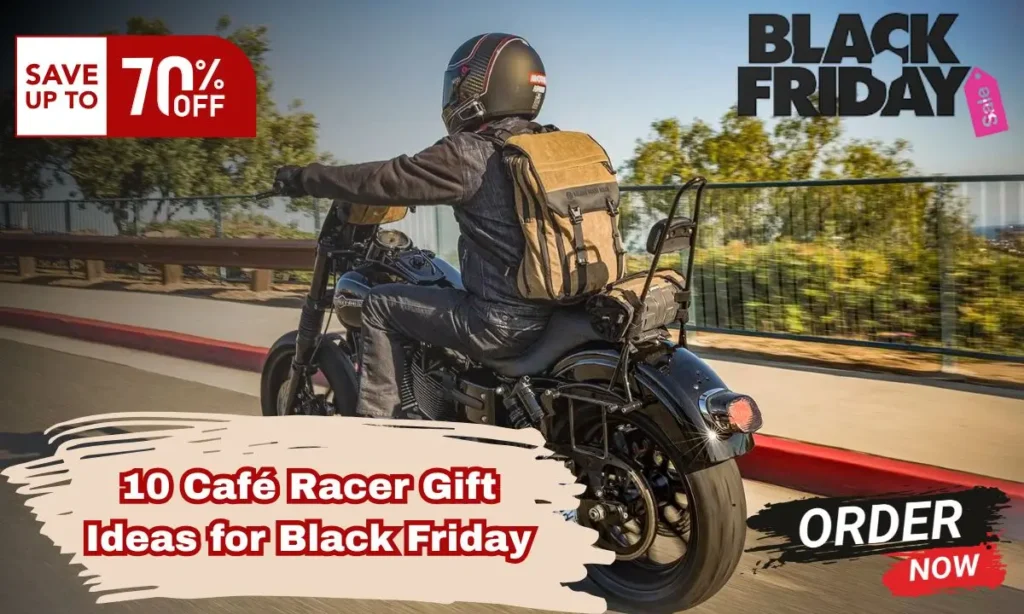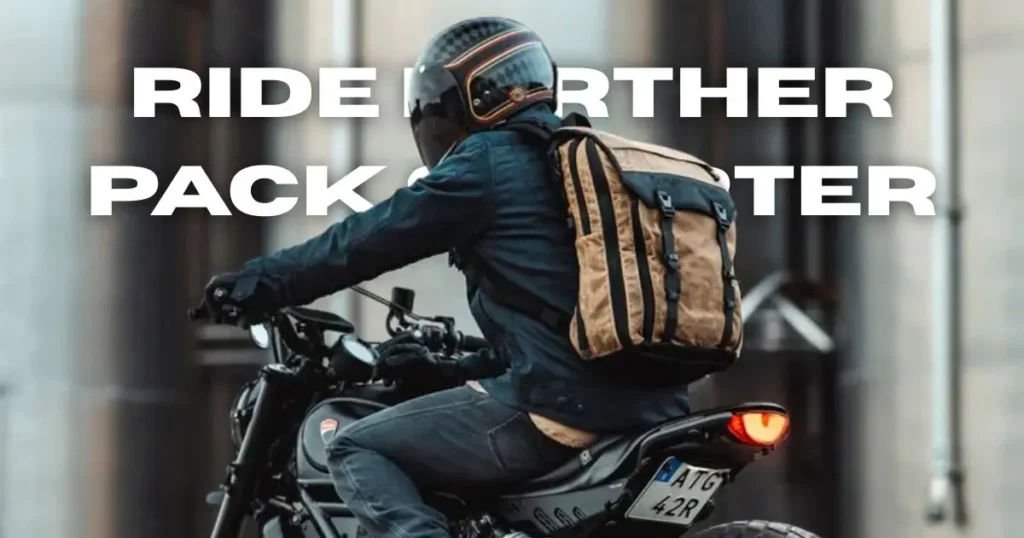Table of Contents
ToggleWhen you think about making a café racer, two cool bikes come to mind: the Honda CB550 and the Honda CB750. These two bikes are loved by people who like motorcycles and enjoy building them. But if you want to turn one into a café racer, you might ask yourself: Which one is better for this?
In this article, we’ll talk about the differences between the Honda CB550 and CB750. We’ll look at things like how fast they go, how easy they are to change, and how much money they cost. This will help you choose which bike is best for your café racer project. Do you want a bike that is light and easy to ride, or do you want one with more power? I’ll help you pick!
Before we get into the details, let’s talk about why these bikes are special. The Honda CB550 is like the “middle” bike in Honda’s family. It is liked because it’s not too heavy and its engine works well. The CB750, however, is called the first superbike. It’s known for being fast, strong, and it changed the history of motorcycles.
But which one is better for your café racer dream? Let’s find out!
Overview of Honda CB550 and CB750
Let’s take a closer look at the Honda CB550 and CB750 so you can understand what each bike brings to the table before converting it into a café racer. These two models have distinct features that make them ideal candidates for customization, but they also have important differences that could influence your decision.
Honda CB550: The Middleweight Contender

The Honda CB550 is often called the “little brother” to the CB750, but don’t let that fool you. This bike is known for its balanced performance, making it a favorite among builders who want a more agile café racer. Here are some key specs:
- Engine: 544cc, 4-cylinder, air-cooled
- Horsepower: Around 50 HP
- Weight: Approximately 415 lbs (dry weight)
- Top Speed: 100-110 mph
- Fuel Capacity: 4.2 gallons
What makes the CB550 stand out is its lighter weight, which makes it easier to handle than the heavier CB750. If you’re aiming for a café racer that gives you nimble performance and great handling, especially in the city, the CB550 is a great pick. Its 8-valve engine gives you enough power for fun, spirited riding without being too much for beginners or riders who prefer lighter bikes.
Honda CB750: The Superbike Legend

ThThe Honda CB750, often called the first “superbike,” is famous for its groundbreaking performance when it was introduced in the late 1960s. Here’s a quick look at what you get with the CB750:
- Engine: 736cc, 4-cylinder, air-cooled
- Horsepower: Around 67 HP
- Weight: Approximately 480 lbs (dry weight)
- Top Speed: 120-125 mph
- Fuel Capacity: 5 gallons
The CB750 is the more powerful of the two bikes and changed the motorcycle world when it came out. Its larger engine and higher horsepower make it perfect for riders who want more speed and power in their café racer. While it’s heavier and a bit harder to handle than the CB550, it shines on the open road, offering solid and stable performance.
Key Specs of Honda CB550 vs. CB750
| Feature | Honda CB550 | Honda CB750 |
|---|---|---|
| Engine | 544cc, 4-cylinder | 736cc, 4-cylinder |
| Horsepower | ~50 HP | ~67 HP |
| Dry Weight | ~415 lbs | ~480 lbs |
| Top Speed | 100-110 mph | 120-125 mph |
| Fuel Capacity | 4.2 gallons | 5 gallons |
| Handling | Light and nimble | Stable and powerful |
The CB550 is more manageable and agile, while the CB750 is known for its superior speed and power, giving it a stronger, more dominant presence on the road.
Performance and Handling for Café Racer Builds
Now that we’ve covered the basic specs of both the Honda CB550 and CB750, let’s dive into how these bikes perform once turned into café racers. Performance and handling are two key factors to think about when customizing your bike. Whether you want a smooth, nimble ride or a powerful beast on the road, both models have their own unique advantages.
Honda CB550: Lightweight and Nimble
The Honda CB550 stands out for its lightweight frame and agile handling. When turned into a café racer, these traits become even more important since café racers are built for quick, spirited rides. The lower weight (around 415 lbs) makes it easier to handle, especially for riders who want to zip through city streets or twisty back roads.
Pros:
- Easier to maneuver in tight spaces
- Better handling in urban environments
- Lighter weight allows for more agile riding, especially with café racer mods like clip-on handlebars and rear-set foot pegs
- Balanced power-to-weight ratio: While not as powerful as the CB750, the lower weight makes up for it, giving the bike a responsive feel
Riders often say the CB550 feels more playful and responsive, making it a fun choice for those who care more about handling than raw power. The smaller engine size also makes customizing easier. You’ll find it’s simpler to work on, and there are plenty of aftermarket parts that are often cheaper than those for the CB750.
Honda CB750: Power and Stability
If you’re more interested in power and stability, the Honda CB750 delivers. Known as the world’s first superbike, the CB750 comes with a larger, more powerful engine (736cc) and offers 67 horsepower. This makes it a solid choice for café racer enthusiasts who value speed and want a bike that feels strong on the highway or long, open roads.
Pros:
- Higher horsepower for those who want a fast, thrilling ride
- Stable at high speeds: Thanks to its weight and larger engine, the CB750 excels on highways and longer routes where speed is a priority
- More powerful acceleration, making it a better option for riders who want a café racer that can keep up with modern bikes
However, it’s important to note that the CB750’s extra weight (480 lbs) can make it feel sluggish in tight spaces or urban environments. If your goal is to ride your café racer through tight city streets or on short, winding roads, the CB750 might not be as nimble as the CB550.
Handling Comparison
When it comes to handling, the CB550 is generally the better choice for those who want a nimble, light bike for city riding or casual weekend rides. The CB750, however, excels on the open road, where its stability at high speeds and more powerful engine offer a thrilling ride.
| Aspect | Honda CB550 | Honda CB750 |
|---|---|---|
| Agility in corners | More agile, better in cities | Stable, heavier, harder to corner |
| High-speed stability | Good, but not as stable at high speeds | Excellent, ideal for highways |
| Acceleration | Adequate, not overwhelming | Powerful acceleration, strong performance |
| Power-to-weight ratio | Balanced, lighter, easier to control | Powerful but heavier, harder to maneuver in tight spaces |
Which Bike Suits Your Riding Style?
If you’re planning on cruising through city streets or taking shorter rides, the Honda CB550 is likely the better fit because of its agility and lightweight handling. On the other hand, if you’re aiming for longer rides on highways or want more raw power, the CB750 might be your ideal choice.
How Easy is it to Customize?
When it comes to café racer conversions, one of the most important things to think about is how easy the bike is to customize. Whether you’re an experienced builder or a first-timer, knowing how much effort, time, and money you’ll need to invest is key. Let’s break down how the Honda CB550 and Honda CB750 compare when it comes to customization ease.
Honda CB550: Simplicity and Flexibility
The Honda CB550 is often seen as a more forgiving platform for café racer conversions, especially for those new to customizing motorcycles. Its smaller size and simpler engine layout make it easier to work with, especially when you’re going for that clean, minimalist café racer look.
- Frame Modifications: The CB550’s frame is easier to modify compared to the CB750. Builders often find that customizing the subframe to fit a custom seat or rear cowl is more straightforward on the CB550. Since it’s a smaller and lighter bike, it doesn’t need as many complex changes to get the classic café racer silhouette.
- Engine Tuning: The 544cc engine is simpler to tune, and for those who want to make engine mods, the CB550’s power can be adjusted without needing to overhaul major parts. Many builders choose basic upgrades like carb tuning or exhaust changes to give it more punch while keeping its easy-going nature.
- Availability of Aftermarket Parts: There’s a wide selection of aftermarket parts for the CB550, including clip-on handlebars, rear-set foot pegs, and custom exhaust systems. Parts for the CB550 are often cheaper and more widely available, making it a great option for budget-conscious builders.
Honda CB750: More Complex but Rewarding
The Honda CB750 is a powerhouse, but that extra power comes with a more complex structure that can be trickier to modify. While the CB750 is certainly customizable, it requires a bit more expertise and time, especially for those looking to significantly alter its appearance or performance.
- Frame Modifications: Due to its larger frame, the CB750 requires more extensive modifications if you’re aiming to achieve a sleek café racer look. Subframe alterations are common, but they can be more challenging because of the bike’s weight and size. Some builders may need to cut or reinforce parts of the frame to handle the CB750’s added power after customization.
- Engine Tuning: The 736cc engine is more powerful but also more complicated. Tuning the engine for better performance or smoother handling often involves more intricate work, such as upgrading the ignition system or installing more advanced carburetors. This is where the CB750 can become more expensive to customize, as performance parts are often pricier.
- Aftermarket Support: The CB750 enjoys strong aftermarket support, with plenty of options for performance upgrades, such as 4-into-1 exhaust systems, improved suspension, and disc brake conversions. However, these parts are typically more expensive than those for the CB550, and installation can be more complex.
Customization Comparison: CB550 vs. CB750
| Aspect | Honda CB550 | Honda CB750 |
|---|---|---|
| Frame Modifications | Easier, simpler structure | More complex, may require cutting |
| Engine Tuning | Simpler, easier to maintain | More complex, higher potential for power |
| Aftermarket Parts | Affordable and widely available | More expensive, but robust aftermarket |
| Customization Cost | Budget-friendly | Higher cost for advanced modifications |
| Time Investment | Quicker, less labor-intensive | Longer, more intricate modifications |
Which Bike Is Easier to Customize?
If you’re a beginner or looking for a more affordable and less complex customization process, the Honda CB550 is your best choice. It’s easier to modify, and the parts are generally more affordable. However, if you’re more experienced and want a more powerful, standout build, the Honda CB750 is worth the extra effort and investment, though it requires more time and expertise.
Cost Considerations
Now let’s talk about one of the most important parts of any café racer build: cost. Whether you’re on a tight budget or aiming to create a high-end custom bike, knowing the costs involved in turning a Honda CB550 or CB750 into a café racer is essential.
Cost of Buying a Donor Bike
The first cost to think about is the price of the donor bike, which can change based on its condition and availability. Generally, the Honda CB550 tends to be a bit cheaper than the CB750.
- Honda CB550: You can usually find a decent CB550 for between $2,500 to $4,500, depending on its condition and any modifications already done to it. Since it’s smaller and less powerful than the CB750, its market price is often lower, making it a great option for those with a tighter budget.
- Honda CB750: The CB750, being the first superbike, can come with a higher price tag. Expect to pay around $3,500 to $6,000 for a good condition donor bike. The price can increase if the bike is in excellent condition or has been partially customized already.
Customization Costs
Once you’ve got your donor bike, the next big expense comes from the parts and labor needed to turn it into a café racer. The Honda CB550 usually costs less to customize because its parts are more affordable, and the modifications needed are not as extensive.
Honda CB550 Customization Costs:
- Clip-on handlebars: $50 – $150
- Rear-set foot pegs: $100 – $250
- Café racer seat: $100 – $300
- Exhaust system: $300 – $600
- Carburetor upgrade: $150 – $400
- Paint job: $500 – $1,000
On average, you can expect to spend between $1,500 to $3,000 on basic modifications for a Honda CB550 café racer build. If you choose more premium parts, the costs can go up, but this bike usually stays within a reasonable range for most builders.
Honda CB750 Customization Costs:
- Clip-on handlebars: $80 – $200
- Rear-set foot pegs: $150 – $300
- Café racer seat: $150 – $400
- Exhaust system: $400 – $800
- Carburetor upgrade: $200 – $500
- Paint job: $600 – $1,500
The CB750’s customization can cost a bit more because of its larger, more powerful engine and the more complex frame modifications. You’re likely to spend around $2,000 to $4,500 on modifications for a CB750 café racer, depending on how far you want to go with performance upgrades and premium parts.
Total Cost Comparison
| Cost Aspect | Honda CB550 | Honda CB750 |
|---|---|---|
| Donor Bike | $2,500 – $4,500 | $3,500 – $6,000 |
| Customization Costs | $1,500 – $3,000 | $2,000 – $4,500 |
| Total Estimated Cost | $4,000 – $7,500 | $5,500 – $10,500 |
Maintenance and Long-Term Costs
Both bikes are known for their reliability, but the Honda CB750 may come with slightly higher long-term costs because of its larger engine and more complex structure. Parts like replacement exhaust systems, ignition systems, and brake upgrades tend to be more expensive for the CB750.
Which Bike Is More Budget-Friendly?
If you’re looking for a more cost-effective café racer conversion, the Honda CB550 is the better choice. Not only is the donor bike usually cheaper, but the customization and maintenance costs are often lower. On the other hand, if you’re willing to invest more for extra performance and power, the Honda CB750 can be worth the higher price tag.
Popularity in the Café Racer Community
When it comes to café racer conversions, both the Honda CB550 and CB750 have strong reputations among builders and enthusiasts. However, the reasons for their popularity are a bit different. While the CB750 often steals the spotlight for its powerful engine and status as the “original superbike,” the CB550 is loved for its nimbleness and affordability.
Honda CB550: A Community Favorite for Balanced Builds
The Honda CB550 has steadily gained popularity in the café racer community, especially among those who prefer a lighter, more manageable build. Its size and weight make it a great canvas for builders who want a bike that handles well, particularly on city streets and twisty roads.

Why It’s Popular:
- Manageable size: Many builders choose the CB550 because it strikes a good balance between power and weight. It’s not too heavy or bulky, making it ideal for riders who want a classic look without losing agility.
- Wide availability of parts: As more builders turn CB550s into café racers, the aftermarket parts scene has grown, making it easier to find affordable components for custom builds.
- Aesthetic appeal: The CB550’s smaller frame works well for clean, minimalist designs, which is a big draw in the café racer world. Builders love the sleek lines and simple modifications that showcase the bike’s classic beauty.
The CB550 is often called the perfect middleweight, making it popular with both beginners and experienced builders. It’s a bike that can be customized on a budget without sacrificing style or performance.
Honda CB750: The Iconic Superbike
While the CB550 holds its own in the café racer scene, the Honda CB750 enjoys a legendary staThe Honda CB750 holds a legendary status, not just for café racer conversions, but in motorcycle history as a whole. Known as the world’s first superbike, the CB750 delivers more power and makes a bigger statement on the road.

Why It’s Popular:
- Power and speed: Café racer enthusiasts looking for a bike with more punch often choose the CB750. Its larger engine provides more horsepower, making it perfect for those who want both speed and performance with the café racer style.
- Historic significance: The CB750 is more than just a bike; it’s a piece of history. Many riders are drawn to this model because of its cultural impact and the prestige that comes with owning a bike that helped shape modern motorcycling.
- Custom potential: The CB750’s large frame and engine offer endless possibilities for customization. Builders often enhance its performance, adding modern upgrades that take full advantage of its strong structure.
However, some in the café racer community find the CB750’s extra weight and bulkier size to be a drawback. This can make it harder to achieve the minimalist look café racers are known for. But for those who crave raw power, the CB750 remains a top choice.
Community Preferences: Which Model Do Builders Prefer?
When it comes to community preferences, the CB550 is generally favored by riders who value easy customization and a lighter, more agile build. Many first-time builders choose the CB550 because of its manageable size and the affordability of parts. It’s also ideal for urban riders who want a café racer that’s easy to handle.
The CB750, on the other hand, attracts builders seeking more power and a bike with a stronger historic legacy. Its status as the first superbike gives it a sense of prestige, and for those who can manage the extra weight, it’s an iconic choice for café racer conversions.
| Model | Why It’s Popular | Who Prefers It |
|---|---|---|
| Honda CB550 | Lightweight, easy to handle, great for clean designs | Builders who want a nimble, affordable build |
| Honda CB750 | More power, historic significance, customizable potential | Riders who value speed, performance, and legacy |
Examples of Notable Café Racer Builds: My Personal Take
CB550 Builds
The Honda CB550 has been used as the base for some truly impressive café racer conversions. These range from sleek, minimal designs that focus on lightweight agility to builds that capture a vintage style while adding modern touches. There’s a lot of inspiration to draw from. In the builds I’ve reviewed, there’s often a great balance between performance and simplicity, making for a bike that’s both easy to handle and stunning to look at.
As I continue to explore more of these builds, I’ll be sharing my thoughts on what works well and what could be improved. Don’t miss out on my reviews of these CB550 conversions to see how each builder makes the most of this iconic bike’s agility and style.
CB750 Builds
The Honda CB750 is often chosen by builders who want to combine power with a classic café racer look. Some of these conversions focus on performance upgrades like high-performance exhaust systems and suspension improvements, while others aim to preserve the bike’s history while boosting its road-handling abilities.
In my reviews, I’ve looked at how these builds push the CB750 to its limits. The results are often remarkable, showing a perfect mix of modern performance with a timeless design. Check out my detailed reviews to see which customizations stand out and which upgrades truly enhance the experience of riding this legendary bike.
Which is Better for Café Racer Conversion?
Deciding between the Honda CB550 and CB750 for a café racer conversion depends on what matters most to you—agility or power. The CB550 is a great choice if you want a bike that’s easy to handle and perfect for city streets. It’s lighter, easier to work on, and typically cheaper. If you care more about maneuverability and affordable modifications, this bike will suit you. But, it might not be the best option if you’re looking for high-speed performance on highways, as it doesn’t pack as much power.
On the other hand, the Honda CB750 is all about power. Its bigger engine and higher horsepower make it a good choice for those who want an exciting ride, especially on highways or long trips. However, it’s heavier, harder to manage in traffic, and usually costs more to buy and customize. The CB750 is for riders who value speed, performance, and want the prestige of owning a legendary bike, even if it requires more time, money, and effort to convert.
To put it simply, if you want a lightweight, budget-friendly café racer, go with the CB550. But if power and performance are more important, the CB750 is the better choice, even though it comes with extra costs and weight.
My Recommendation
If you’re new to café racer conversions or want a bike that’s easy to work with, go with the Honda CB550. It’s more budget-friendly and offers a fun, agile ride that’s perfect for short trips and city cruising. However, if you’re looking for more power and are willing to put in the extra effort, the Honda CB750 could be the better choice, especially if you plan on riding highways or want the prestige of owning a piece of motorcycle history.
Disclaimer
The information in this article is based on research and personal experience with motorcycle customization, specifically café racer conversions. While every effort has been made to ensure the accuracy of the details regarding the Honda CB550 and CB750, keep in mind that individual results may vary depending on the condition of the motorcycle, parts availability, and the customization process. Prices and availability of donor bikes and parts mentioned here are estimates and can change based on location, condition, and market trends.
Before starting any modifications or purchases, it’s recommended to consult with professional builders, mechanics, or experts to ensure your chosen motorcycle and parts match your needs and goals. The decisions for your café racer project should be based on personal preference, skill level, and how you plan to use the bike. We do not take responsibility for any outcomes or costs related to the modifications discussed in this article.
FAQs
Which is easier to customize: the Honda CB550 or CB750?
The Honda CB550 is easier to customize because of its lighter frame and simple structure. It’s a great choice for first-time builders or anyone on a budget. The CB750 has more power and performance but needs more time, expertise, and money to customize.
Is the Honda CB550 better for city riding?
Yes, the Honda CB550 is lighter and more agile, making it perfect for city riding. Its smaller frame makes it easier to navigate through tight spaces, unlike the heavier CB750.
What makes the Honda CB750 popular for café racer conversions?
The Honda CB750 is famous for its higher horsepower and its history as the first superbike. It’s great for people who want power and stability on highways, which makes it a popular choice for café racer conversions.
Which bike is more cost-effective to turn into a café racer: CB550 or CB750?
The Honda CB550 is usually more cost-effective because donor bikes and parts are cheaper. The CB750 costs more, both for the bike itself and for performance upgrades, making the CB550 a better option for builders on a budget.
Is the Honda CB750 too heavy for café racer conversions?
The Honda CB750 is heavier than the CB550, which makes it harder to handle in tight city spaces. But that extra weight adds stability and power, making it great for those who love speed and long highway rides.



